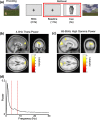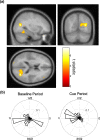Medial prefrontal theta phase coupling during spatial memory retrieval
- PMID: 24497013
- PMCID: PMC4028411
- DOI: 10.1002/hipo.22255
Medial prefrontal theta phase coupling during spatial memory retrieval
Abstract
Memory retrieval is believed to involve a disparate network of areas, including medial prefrontal and medial temporal cortices, but the mechanisms underlying their coordination remain elusive. One suggestion is that oscillatory coherence mediates inter-regional communication, implicating theta phase and theta-gamma phase-amplitude coupling in mnemonic function across species. To examine this hypothesis, we used non-invasive whole-head magnetoencephalography (MEG) as participants retrieved the location of objects encountered within a virtual environment. We demonstrate that, when participants are cued with the image of an object whose location they must subsequently navigate to, there is a significant increase in 4-8 Hz theta power in medial prefrontal cortex (mPFC), and the phase of this oscillation is coupled both with ongoing theta phase in the medial temporal lobe (MTL) and perceptually induced 65-85 Hz gamma amplitude in medial parietal cortex. These results suggest that theta phase coupling between mPFC and MTL and theta-gamma phase-amplitude coupling between mPFC and neocortical regions may play a role in human spatial memory retrieval.
Keywords: MEG; MTL; hippocampus; mPFC; oscillations.
© 2014 The Authors. Hippocampus Published by Wiley Periodicals, Inc.
Figures



Similar articles
-
Medial Prefrontal-Medial Temporal Theta Phase Coupling in Dynamic Spatial Imagery.J Cogn Neurosci. 2017 Mar;29(3):507-519. doi: 10.1162/jocn_a_01064. Epub 2016 Oct 25. J Cogn Neurosci. 2017. PMID: 27779906 Free PMC article.
-
A causal role for the precuneus in network-wide theta and gamma oscillatory activity during complex memory retrieval.Elife. 2019 Feb 11;8:e43114. doi: 10.7554/eLife.43114. Elife. 2019. PMID: 30741161 Free PMC article.
-
Impaired theta phase coupling underlies frontotemporal dysconnectivity in schizophrenia.Brain. 2020 Apr 1;143(4):1261-1277. doi: 10.1093/brain/awaa035. Brain. 2020. PMID: 32236540 Free PMC article.
-
Coherent Coding of Spatial Position Mediated by Theta Oscillations in the Hippocampus and Prefrontal Cortex.J Neurosci. 2019 Jun 5;39(23):4550-4565. doi: 10.1523/JNEUROSCI.0106-19.2019. Epub 2019 Apr 2. J Neurosci. 2019. PMID: 30940717 Free PMC article.
-
Phase-Amplitude Coupling and Phase Synchronization Between Medial Temporal, Frontal and Posterior Brain Regions Support Episodic Autobiographical Memory Recall.Brain Topogr. 2022 Mar;35(2):191-206. doi: 10.1007/s10548-022-00890-4. Epub 2022 Jan 26. Brain Topogr. 2022. PMID: 35080692 Free PMC article.
Cited by
-
Long-Term Dynamical Constraints on Pharmacologically Evoked Potentiation Imply Activity Conservation within In Vitro Hippocampal Networks.PLoS One. 2015 Jun 12;10(6):e0129324. doi: 10.1371/journal.pone.0129324. eCollection 2015. PLoS One. 2015. PMID: 26070215 Free PMC article.
-
The limbic-reticular coupling theory of memory processing in the brain and its greater compatibility over other theories.Dement Neuropsychol. 2018 Apr-Jun;12(2):105-113. doi: 10.1590/1980-57642018dn12-020002. Dement Neuropsychol. 2018. PMID: 29988336 Free PMC article.
-
Medial Prefrontal-Medial Temporal Theta Phase Coupling in Dynamic Spatial Imagery.J Cogn Neurosci. 2017 Mar;29(3):507-519. doi: 10.1162/jocn_a_01064. Epub 2016 Oct 25. J Cogn Neurosci. 2017. PMID: 27779906 Free PMC article.
-
Short Sleep Makes Declarative Memories Vulnerable to Stress in Humans.Sleep. 2015 Dec 1;38(12):1861-8. doi: 10.5665/sleep.5228. Sleep. 2015. PMID: 26158890 Free PMC article.
-
Increased Hippocampus-Medial Prefrontal Cortex Resting-State Functional Connectivity and Memory Function after Tai Chi Chuan Practice in Elder Adults.Front Aging Neurosci. 2016 Feb 16;8:25. doi: 10.3389/fnagi.2016.00025. eCollection 2016. Front Aging Neurosci. 2016. PMID: 26909038 Free PMC article.
References
-
- Abrahams S, Pickering A, Polkey CE, Morris RG. Spatial memory deficits in patients with unilateral damage to the right hippocampal formation. Neuropsychologia. 1997;35:11–24. - PubMed
-
- Anderson KL, Rajagovindan R, Ghacibeh GA, Meador KJ, Ding M. Theta oscillations mediate interaction between prefrontal cortex and medial temporal lobe in human memory. Cereb Cortex. 2010;20:1604–1612. - PubMed
-
- Asada H, Fukuda Y, Tsunoda S, Yamaguchi M, Tonoike M. Frontal midline theta rhythms reflect alternative activation of prefrontal cortex and anterior cingulate cortex in humans. Neurosci Lett. 1999;274:4–14. - PubMed
Publication types
MeSH terms
Grants and funding
LinkOut - more resources
Full Text Sources
Other Literature Sources

